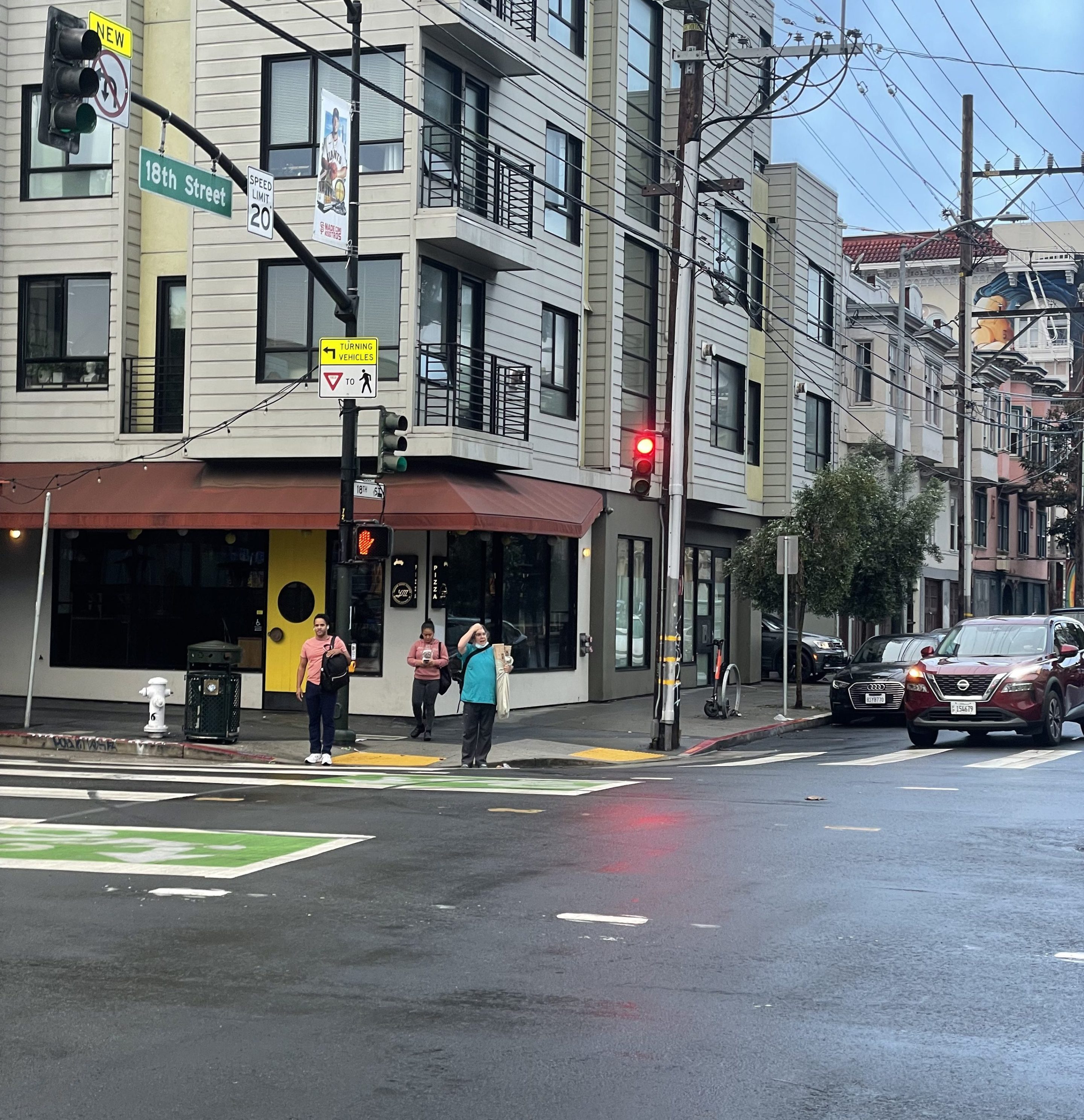Note: GJEL Accident Attorneys regularly sponsors coverage on Streetsblog San Francisco and Streetsblog California. Unless noted in the story, GJEL Accident Attorneys is not consulted for the content or editorial direction of the sponsored content.
During an SFMTA board meeting in April, Director Jeffrey Tumlin repeatedly referred to "fatal flaws" in the plan for protected bike lanes and intersections for Valencia Street that he inherited in 2020 and then promptly destroyed. At that meeting, the board instead approved Valencia's experimental, unproven, and confusing center-running bike lane.
The center-running bike lane was installed. And now someone has been killed. On Wednesday, Sept. 20, in daylight, a left-turning motorist ran over Jian Huang, 80. I was far from alone in predicting it was a matter of time before someone died on Valencia with the street redesign, but even I didn't anticipate it happening just two months after the center-running bike lane officially opened.
Advocacy organizations, in lock step with SFMTA, are trying to ignore the timing of Huang's death. In their messaging, they've simply cut and pasted the usual "thoughts and prayers" without mentioning the proverbial elephant on Valencia Street.
Yesterday, a person driving made a left turn on 18th at Valencia, and struck and killed an 80 year old man who was crossing the street. https://t.co/4Dy3jgILcz
— SF Bicycle Coalition (@sfbike) September 21, 2023
With all due respect to our advocacy allies, these deaths are indeed preventable - so can we get back to advocating for infrastructure that actually does so?
First, in case you missed it from the lead photo, this is SFMTA's solution for "improving" its fundamentally flawed design: a sign. It's a small sign requesting that already-oblivious motorists don't run down pedestrians.
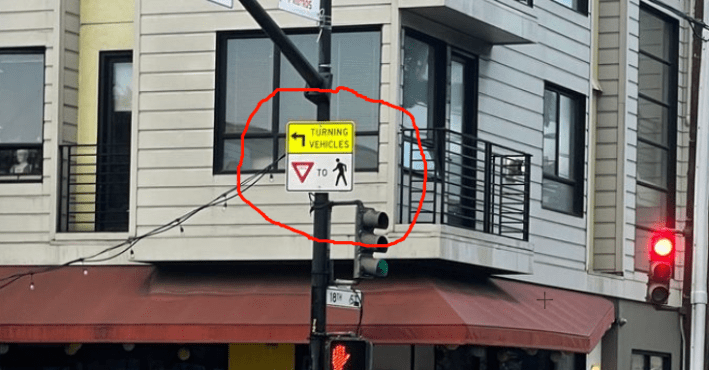
Oh, and they added two plastic speed bumps. These are set behind the crosswalks, however, where they don't do jack to save pedestrians.
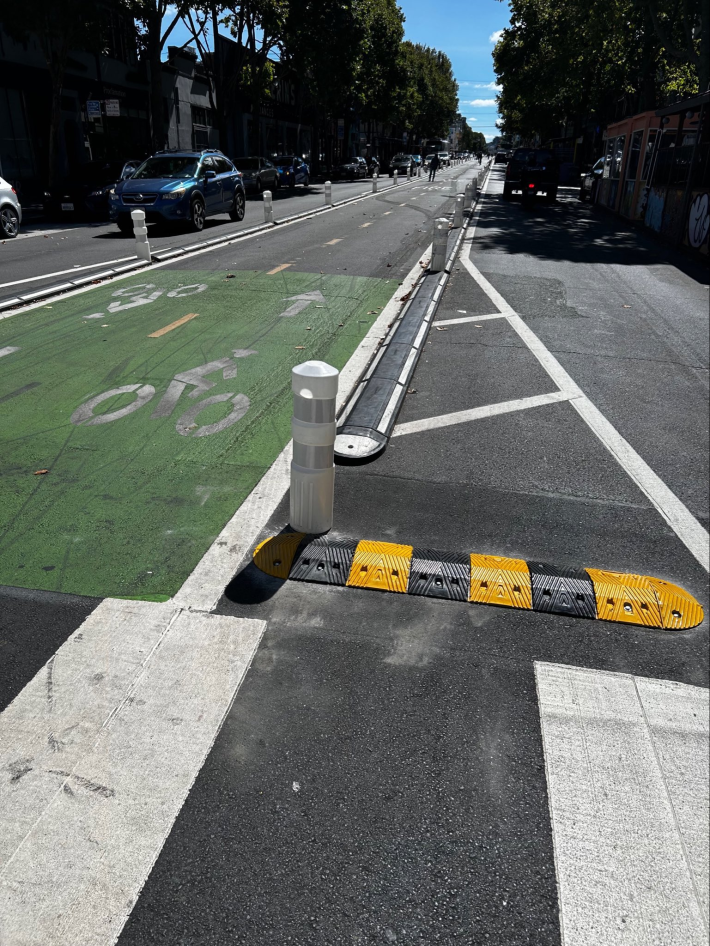
So was the center-running bike lane to blame for this particular tragedy? There usually isn't much one can say definitively about a single collision, but I can say this much: it's simply not credible that a little sign and a plastic bump would have saved Huang's life. Nor will it make much difference going forward.
In the past year, one other pedestrian has been killed on Valencia, at the intersection with 16th. At least two others have died in the past ten years, going by city collision data. Now, almost immediately after the opening of this experimental design, another pedestrian has died.
Given the stream of anecdotal evidence coming in about serious crashes and close-calls, it's an interesting coincidence. I've been covering the goings-on with Valencia since 2015 when I took over at Streetsblog San Francisco. Although I have reported on many crashes, I hadn't personally seen any until after the center-running bike lane went in--and since then I've witnessed two incidents, one of which required an ambulance (see picture below). In the other, a pedestrian tripped over the black bus curb and fell into the traffic lane. It was just luck that she wasn't crushed by oncoming traffic--the incident was a direct result of the new installation.
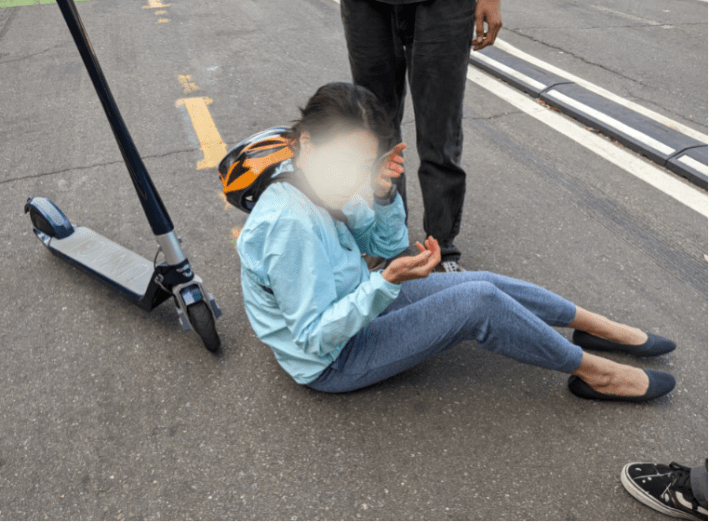
This should surprise no one who is paying attention: international experts have warned in no uncertain terms that putting a bike lane in the center of the street is a bad idea. Moreover, SFMTA's own Jamie Parks was an author of the study that concluded that Washington DC's center-running lane contributed to a higher crash rate there. When I was in Europe at a conference for bicycle safety I asked many, many people about the center-running bike lane. They all agreed it has no place on a commercial corridor such as Valencia.
The international experts will also tell you that properly designed protected bike lanes and protected intersections don't just make things safer for cyclists, they make things safer for all road users, including pedestrians.
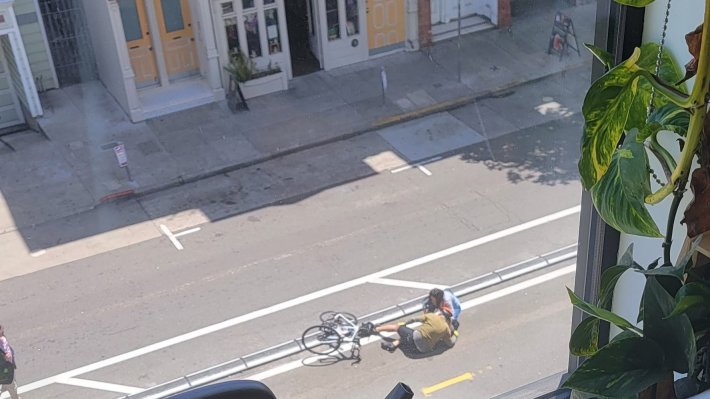
They do, however, require a willingness to lose parking spaces.
Protected bike lanes and intersections force motorists to slow down at intersections, where most serious crashes occur. They allow for more reaction time to avoid a crash. Lower speeds result in lower energy transfer--so pedestrians and cyclists have a better chance of surviving a crash with a motorist if they do occur. And the lanes shorten the crossing distance where pedestrians are exposed to turning drivers in the first place, making crashes less likely.
This was my friend. The driver took an illegal left through the bike lane onto Sycamore (despite that street already running the wrong way) and hit her. She has a broken wrist. She told me if she wasn’t wearing a helmet, she almost certainly would’ve been badly concussed.
— Elias Rappaport (@elias_rappaport) September 25, 2023
When I went last week to look at the site where Huang was killed, a left-turning Tesla driver swept across the same crosswalk and drove over the already squashed K-71 post at the corner. This kind of unsafe turning movement is encouraged by the lack of a protected intersection or pedestrian refuge. And the center-running bike lane does nothing to improve on that situation.
Biked the center Valencia bike lane today for the first time. Perfect. No notes. @sfbike @SFMTA_Muni pic.twitter.com/GnK1Pvnyeu
— Brad Kayal (@withayou) September 9, 2023
Is it a coincidence that several people have already gone to the hospital since the new lane went in, and that one man is dead? Maybe all the people in the Netherlands are wrong and Tumlin is right and the blood that's already been shed is just because this is an adjustment period (even though the protected bike lanes farther down Valencia and in Oakland did not result in a deadly adjustment period).
Or maybe it's just the predictable results of going against international best practices and repeating an experiment with a failed design.
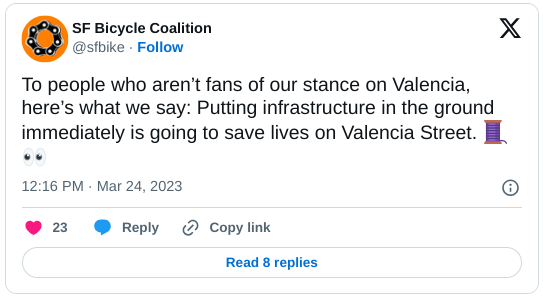
Walk San Francisco and the San Francisco Bicycle Coalition have a professional and moral obligation to reverse their positions and demand SFMTA put in the protected bike lanes and intersections they promised in 2020 (obviously, pedestrianization is another option, one which this publication fully supports).
Otherwise, they need to answer this on behalf of their members: how many people have to crash, how many people have to die, before they will formally oppose the city's "experiment" on Valencia Street?
Note: an earlier version of this story wrongly stated that one other pedestrian was killed in the past ten years on Valencia. There were three, but not all show up on the city's Vision Zero database.
